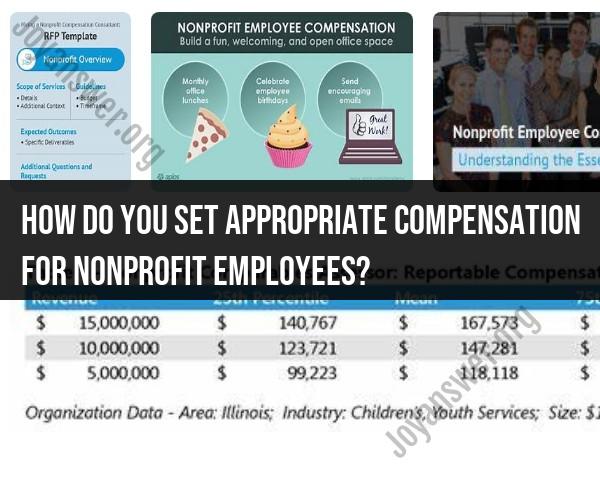How do you set appropriate compensation for Nonprofit employees?
Setting appropriate compensation for nonprofit employees is crucial to attract and retain talent while ensuring that the organization's resources are used effectively for its mission. Here are some best practices for setting compensation in nonprofit organizations:
Understand Legal and Regulatory Guidelines:Be aware of federal, state, and local laws and regulations related to nonprofit compensation, including rules about reasonable compensation and private inurement. Consult with legal experts to ensure compliance.
Conduct a Compensation Study:Perform a comprehensive compensation study to understand the market rates for similar positions in your geographic area and sector. This study can help determine competitive salary ranges.
Develop Compensation Policies:Create clear and transparent compensation policies that outline how salaries and benefits are determined. Document these policies to demonstrate accountability and fairness.
Set Compensation Committees:Many nonprofits establish compensation committees composed of board members or experts to review and approve salary packages for top executives. This adds an extra layer of oversight and objectivity.
Consider Mission Alignment:Ensure that compensation levels align with the organization's mission and values. High salaries for nonprofit executives can be a concern if they appear excessive compared to the organization's impact.
Determine Salary Bands:Establish salary bands or ranges for different positions within the organization. This can help prevent wage disparities and ensure equitable pay.
Performance-Based Pay:Consider linking compensation to performance, both individual and organizational. Performance-based incentives can motivate and reward employees for achieving goals.
Budget Constraints:Keep in mind that nonprofits often have limited resources. Be realistic about what the organization can afford while maintaining financial stability.
Transparency and Communication:Be transparent with employees about how compensation decisions are made. Open and honest communication can build trust and understanding.
Regularly Review Compensation:Conduct periodic reviews of compensation to ensure that it remains competitive in the job market. Adjust salaries as necessary.
Offer Competitive Benefits:Compensation is not just about salary; benefits, including health insurance, retirement plans, and professional development opportunities, also play a role in attracting and retaining talent.
Consult with Experts:Seek advice from HR professionals, consultants, or organizations that specialize in nonprofit compensation to ensure that your organization's practices are in line with industry standards.
Consider Long-Term Sustainability:Ensure that your compensation decisions are aligned with the long-term sustainability of the organization. Overspending on compensation can harm the financial health of the nonprofit.
Maintain Transparency in Financial Reporting:Nonprofits are often subject to public scrutiny. Be prepared to provide clear and accurate information about executive compensation in annual reports and filings.
Engage Stakeholders:In some cases, it may be beneficial to involve stakeholders, including donors and clients, in discussions about executive compensation, especially in larger nonprofits.
Remember that setting appropriate compensation in nonprofit organizations is a balance between attracting and retaining talented employees and demonstrating responsible stewardship of donor funds. It's important to regularly review and adapt your compensation practices to remain competitive and aligned with your mission and values.
Setting Appropriate Compensation for Nonprofit Employees
Setting appropriate compensation for nonprofit employees can be a challenge. Nonprofits often have limited budgets, and they need to balance their mission with their financial constraints. However, it is important to pay nonprofit employees fairly and competitively in order to attract and retain top talent.
There are a few factors to consider when setting compensation for nonprofit employees:
- Comparable salaries: Nonprofits should pay employees salaries that are comparable to those paid by similar organizations in the same geographic area. This information can be found through salary surveys and other resources.
- Employee experience and education: Nonprofits should take into account employees' experience, education, and skills when setting their compensation. Employees with more experience and education should be paid more than employees with less experience and education.
- Performance: Nonprofits should also consider employee performance when setting compensation. Employees who consistently exceed expectations should be rewarded with higher salaries.
Navigating Compensation Challenges in Nonprofit Organizations
One of the biggest challenges that nonprofits face when it comes to compensation is their limited budgets. Nonprofits often rely on government grants, donations, and other forms of funding. This can make it difficult to set salaries that are comparable to those paid by for-profit companies.
Another challenge that nonprofits face is the need to balance their mission with their financial constraints. Nonprofits want to pay their employees fairly, but they also need to make sure that they are using their resources wisely to achieve their mission.
Factors Influencing Nonprofit Employee Pay Structures
There are a number of factors that can influence nonprofit employee pay structures, including:
- Organization size: Larger nonprofits typically have more resources to devote to compensation than smaller nonprofits.
- Location: Nonprofits in urban areas typically pay their employees more than nonprofits in rural areas.
- Industry: Nonprofits in some industries, such as healthcare and education, typically pay their employees more than nonprofits in other industries.
- Mission: Nonprofits with a more complex or challenging mission may need to pay their employees more in order to attract and retain top talent.
Strategies for Fair and Transparent Compensation Practices
There are a number of strategies that nonprofits can use to ensure fair and transparent compensation practices, including:
- Develop a compensation policy: Nonprofits should develop a compensation policy that outlines their compensation philosophy and procedures. This policy should be reviewed and updated regularly.
- Use salary surveys: Nonprofits should use salary surveys to determine what other organizations in the same geographic area are paying their employees with similar experience and education.
- Conduct performance reviews: Nonprofits should conduct performance reviews regularly to assess employee performance. This information can be used to inform compensation decisions.
- Be transparent with employees: Nonprofits should be transparent with their employees about their compensation process. Employees should know how their salary is determined and what they need to do to earn a raise.
Balancing Mission and Budget in Nonprofit Compensation
Balancing mission and budget in nonprofit compensation can be challenging. Nonprofits want to pay their employees fairly, but they also need to make sure that they are using their resources wisely to achieve their mission.
There are a few ways that nonprofits can balance mission and budget in nonprofit compensation:
- Prioritize mission-critical positions: Nonprofits can prioritize mission-critical positions and pay those employees more. This will help to ensure that the nonprofit has the resources it needs to achieve its mission.
- Offer competitive salaries and benefits: Nonprofits should offer competitive salaries and benefits in order to attract and retain top talent. This will help to ensure that the nonprofit has a strong workforce.
- Be creative with compensation: Nonprofits can be creative with compensation by offering things like flexible work arrangements, professional development opportunities, and recognition programs. This can help to make the nonprofit a more attractive place to work, even if it cannot offer the highest salaries.
By following these tips, nonprofits can set appropriate compensation for their employees and balance their mission with their budget.












